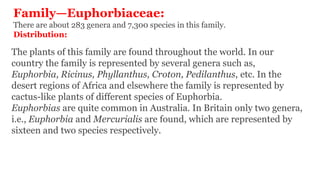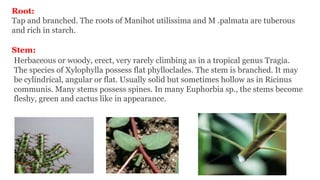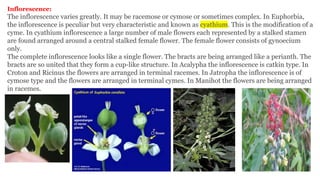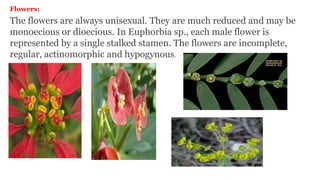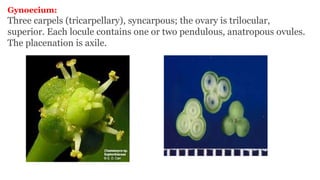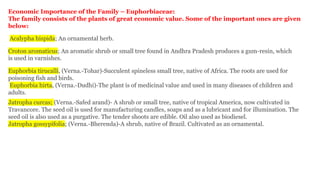Euphorbiaceae
- 1. B.Sc. II Year “ANGIOSPERMS SYSTEMATIC, ANATOMY AND EMBRYOLOGY” Unit – III ‘Angiosperms Systematic’ Family- Euphorbiaceae DR. SWATI V. PUNDKAR Assistant Professor Department of Botany Shri Shivaji Science College, Amravati NAAC Accredited ‘A’ Grade
- 3. Family—Euphorbiaceae: There are about 283 genera and 7,300 species in this family. Distribution: The plants of this family are found throughout the world. In our country the family is represented by several genera such as, Euphorbia, Ricinus, Phyllanthus, Croton, Pedilanthus, etc. In the desert regions of Africa and elsewhere the family is represented by cactus-like plants of different species of Euphorbia. Euphorbias are quite common in Australia. In Britain only two genera, i.e., Euphorbia and Mercurialis are found, which are represented by sixteen and two species respectively.
- 7. Habit: The plants exhibit great variation in their habit. The plants may be herbs, shrubs or trees. Euphorbia hirta, E. thymifolia, E. helioscopica, E. peplus; E. heterophylla, E. cristata, E. elegans; Phyllanthus niruri, Croton sp., Acalypha indica, etc., are annual or prennial herbs. Euphorbia pulcherrima, E. splendens, are beautiful shrubs. Pedilanthus sp., and Jatropha sp., are shrubby plants. Euphorbia royleana, E. tirucalli are cactus like shrubs. Ricinus communis (Arand) is a tall annual and becomes small tree-like in habit. The tree habit of the family is represented by Phyllanthus emblica (Amla), Bischofia javanica, Putranjiva roxburghii, etc. Havea brasiliensist (rubber tree) is a large tree 60 to 100 feet in height and 8- 12 feet in girth. Species of the genus Tragia are tropical climbers. Majority of the members of the family possess large laticiferous vessels which contain latex.
- 8. Root: Tap and branched. The roots of Manihot utilissima and M .palmata are tuberous and rich in starch. Stem: Herbaceous or woody, erect, very rarely climbing as in a tropical genus Tragia. The species of Xylophylla possess flat phylloclades. The stem is branched. It may be cylindrical, angular or flat. Usually solid but sometimes hollow as in Ricinus communis. Many stems possess spines. In many Euphorbia sp., the stems become fleshy, green and cactus like in appearance.
- 9. Leaves: The form and position of leaves are variable. The arrangement is usually alternate but sometimes they are opposite, e.g., Euphorbia hirta. In Pedilanthus the leaves are arranged alternately in the lower region of the plant whereas opposite in the floral region. Usually the leaves are simple but in some they are deeply incised, e.g., Ricinus, Manihot, etc. In many Euphorbias the leaves are scaly and caducous. In many cases the leaves are reduced to spines. In few cases the leaves are replaced by cladodes. Usually the leaves are stipulate. In Jatropha sp., the stipules become branched and hair-like. In many Euphorbia sp., they are represented by glands or spines.
- 10. Inflorescence: The inflorescence varies greatly. It may be racemose or cymose or sometimes complex. In Euphorbia, the inflorescence is peculiar but very characteristic and known as cyathium. This is the modification of a cyme. In cyathium inflorescence a large number of male flowers each represented by a stalked stamen are found arranged around a central stalked female flower. The female flower consists of gynoecium only. The complete inflorescence looks like a single flower. The bracts are being arranged like a perianth. The bracts are so united that they form a cup-like structure. In Acalypha the inflorescence is catkin type. In Croton and Ricinus the flowers are arranged in terminal racemes. In Jatropha the inflorescence is of cymose type and the flowers are arranged in terminal cymes. In Manihot the flowers are being arranged in racemes.
- 11. Flowers: The flowers are always unisexual. They are much reduced and may be monoecious or dioecious. In Euphorbia sp., each male flower is represented by a single stalked stamen. The flowers are incomplete, regular, actinomorphic and hypogynous.
- 12. Perianth: Occasionally, both calyx and corolla are present, e.g., Croton. In majority of cases either calyx or corolla or both are absent. In Ricinus communis the calyx is present and the corolla absent. In Euphorbia hirta both the whorls of calyx and corolla are absent. In Jatropha sp., both calyx and corolla are present. In Acalypha indica the perianth is represented by four minute sepaloid petals. In Phyllanthus only sepaloid perianth is present. In Euphorbia the perianth is absent or represented by tiny scaly structures. The perianth consists of 4 to 5 petals. The calyx and corolla consists of 4 or 5 sepals or petals. The aestivation is valvate or imbricate.
- 13. Androecium: The number of stamens varies from one to many. Usually as many stamens are present as many perianth leaves. In Euphorbia a single stalked stamen represents a single male flower. In Ricinus sp., usually five stamens are present, each stamen is profusely branched. In Jatropha they are arranged in two whorls each of five stamens. In many the stamens are indefinite, e.g., Croton. The filaments may be free or united. The anthers are dithecous. They dehisce either by apical pores or by transverse or longitudinal slits.
- 14. Gynoecium: Three carpels (tricarpellary), syncarpous; the ovary is trilocular, superior. Each locule contains one or two pendulous, anatropous ovules. The placenation is axile.
- 15. Fruit: The fruits are schizocarpic. The fruits break violently and dehisce into one seeded cocci. Such type of fruit is termed regma which is characteristic of Ricinus sp. The sp., of Trewia and Bridelia bear drupe fruit. Phyllanthus emblica also bears drupe. Seeds: The seed is endospermic. In Ricinus caruncle develops from the micropyle. The cotyledons either lie flat or are folded within the endosperm.
- 16. Pollination: Usually entomophilous, i.e., through the agency of insects. Only cross- pollination takes place. In many species the leaves and bracts become coloured and showy to attract the insects. Sometimes anemophily is also found.
- 17. Floral Formulae: The floral formulae of different genera are as follows:
- 18. Economic Importance of the Family – Euphorbiaceae: The family consists of the plants of great economic value. Some of the important ones are given below: Acalypha hispida; An ornamental herb. Croton aromaticus; An aromatic shrub or small tree found in Andhra Pradesh produces a gum-resin, which is used in varnishes. Euphorbia tirucalli, (Verna.-Tohar)-Succulent spineless small tree, native of Africa. The roots are used for poisoning fish and birds. Euphorbia hirta, (Verna.-Dudhi)-The plant is of medicinal value and used in many diseases of children and adults. Jatropha curcas; (Verna.-Safed arand)- A shrub or small tree, native of tropical America, now cultivated in Travancore. The seed oil is used for manufacturing candles, soaps and as a lubricant and for illumination. The seed oil is also used as a purgative. The tender shoots are edible. Oil also used as biodiesel. Jatropha gossypifolia; (Verna.-Bherenda)-A shrub, native of Brazil. Cultivated as an ornamental.
- 19. Hevea brasiliensis; (Eng.-Para rubber; Verna.-Rabar) – A tall tree; native of Brazil;, now grown in Kerala, Tamil Nadu, Karnataka and North-Eastern Assam. The latex, obtained from the bark of the tree, is used for preparing rubber, which is used for tyres and inner tubes, waterproof clothing and various electrical goods. Emblica officinalis; Syn. Phyllanthus emblica; (Verna.-Amla)- A common tree with edible fruits. The fruits are also used in diarrhoea and dysentery. The bark, leaves and fruits are used in dyeing and tanning. The wood yields excellent charcoal. The pickle or jam is prepared from the fruits. The fruit is very rich in vitamin C. Ricinus communis; (Eng.-castor-oil plant; Verna-Arand)-A small tree, cultivated chiefly in Andhra Pradesh, Maharashtra, Karnataka and Orissa. The seeds are the source of castor-oil, which is mainly used as a lubricant and as a purgative. It is also used for transparent soap, textile soap, typewriter- inks, perfume, aromatics, varnishes and paints. The seed cake is used as a fertilizer. The writing and printing-papers are made of the wood-pulp. Castor stems are used for strawboards and cheap wrappings.


